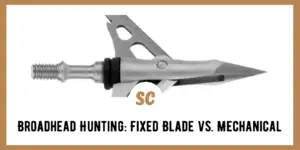Ask bow hunters which broadhead type of arrow is better for hunting, and you’re likely to get the same kind of hot debate as baseball players arguing over wood versus aluminum bats. Like any sport that relies on top grade equipment for differences in performance, crossbow hunting has its own nuances as well. In particular, the issue focuses on whether a broadhead arrow is better as a fixed blade or a mechanical blade. Fixed blade, no surprise, is an arrow head that stays the same regardless of how it is used. The mechanical blade head, however, has moving blade head parts that open on impact, or are supposed to anyways.
SKIP AHEAD
The Fixed Broadhead
A good number of bow hunters are quite committed to the fixed blade. This argument often follows the line of thinking that less moving parts are better. The fixed blade head has no weak points in construction, and there is no risk of it failing in function. The blade penetrates, keeps its shape, and stays stuck in the target.
Most crossbow users follow what the manufacturers advise for an arrowhead, so their crossbow bolts are already fairly heavy compared to regular arrows. Once shot from a crossbow, that weight creates a considerable amount of momentum, which adds to the penetration and damage factor as the bolt hits a target. There is, of course a reason not go stray from the manufacturer’s advice; using a bolt that weighs less than advice can result in serious injury and crossbow damage.
The disadvantages of a fixed blade are bit like the rudder of a boat. When the bolt goes through the air, the fixed blade head doesn’t deviate or change. So that means it sticks out and catches friction with the air. That it turn affects the flight of the bolt like a rudder turns a boat in water. Bow hunters will realize this problem as they miss their targets and have to make small adjustments to compensate for the wind resistance effect.
The Mechanical Broadhead
The mechanical bolt broadhead directly addresses the wind resistance issue by the very design of the head. Instead of catching the wind, the bolt head blades stay recessed and only expand when the bolt hits and penetrates the target, creating the stuck effect arrows are known for. That means, however, less strength for full blade penetration versus a fixed blade arrow head. So, while the mechanical broadhead may improve targeting, it is offset by less of a damaging impact on the target. When your hunting live game, that in turn can be a problem.
Now mechanical broadheads are not cheaply designed. There are some really, really good products out there that open extremely well in an animal target. However, there is always the chance that the mechanical design can fail. A fixed blade head has no failure risk; it penetrates, period.
At the end of the day neither blade will do much good if the tip of the arrow is not sharp enough and strong enough to penetrate the target, including bone. That’s the money-maker part of the arrow. So focus on the bolt tip first, looking for the hardest tip material available for a clean cut, and then worry about the blade type for the rest of the penetration and bolt holding in the target.


